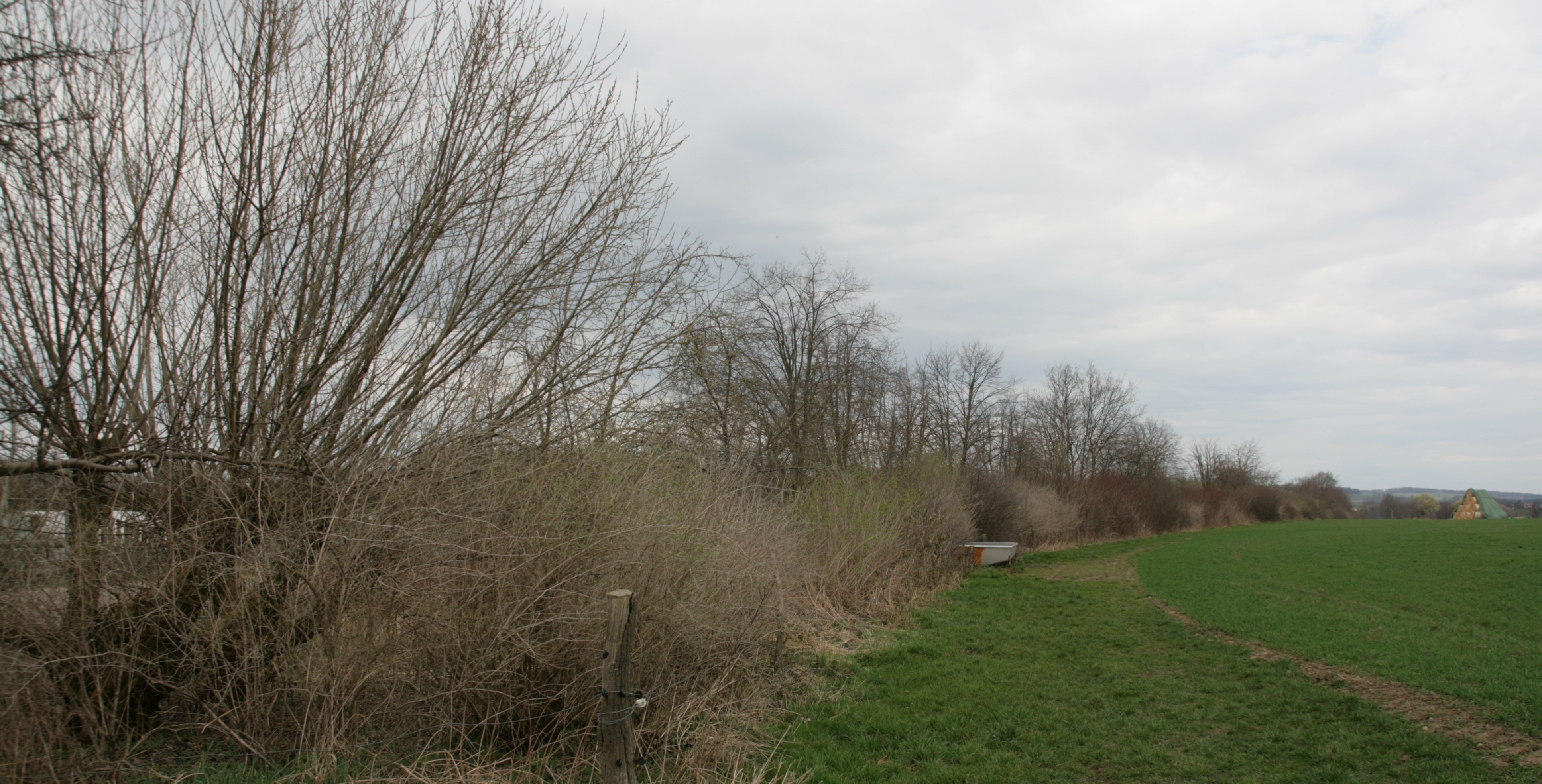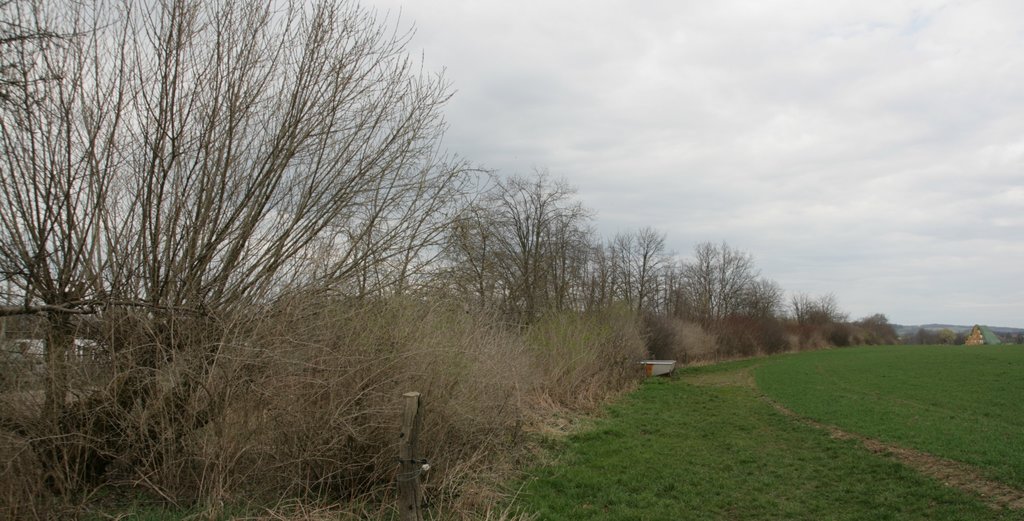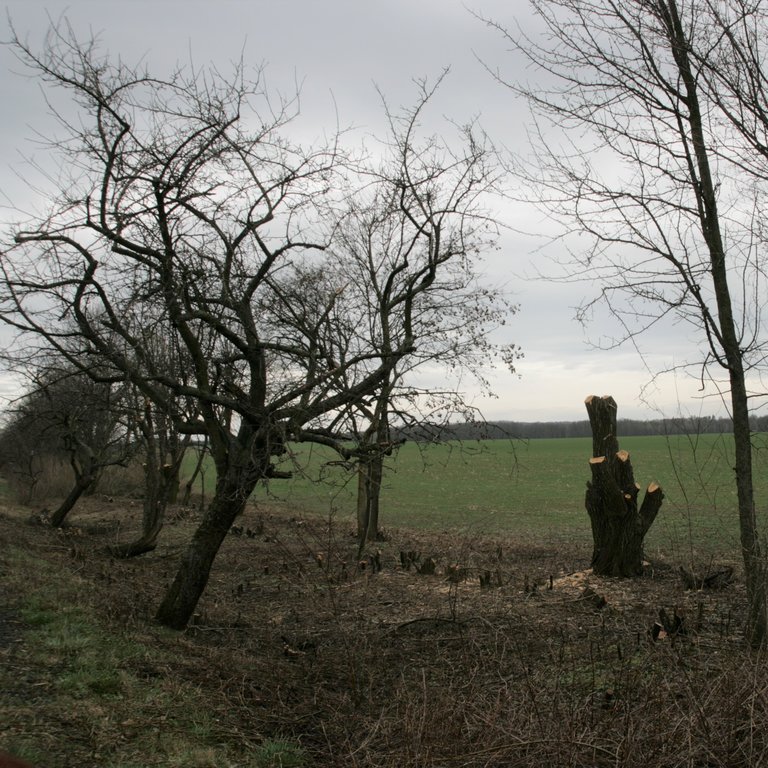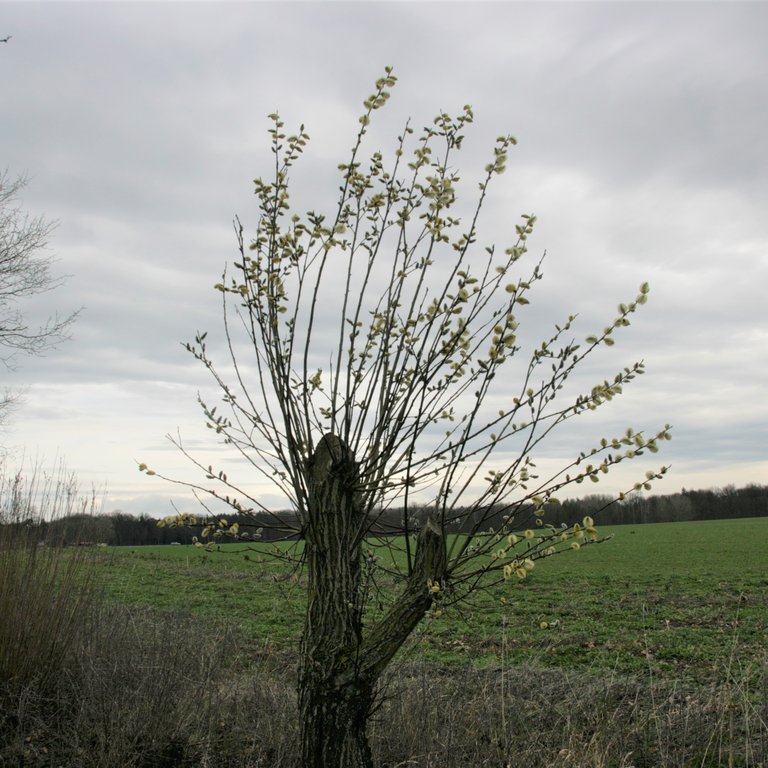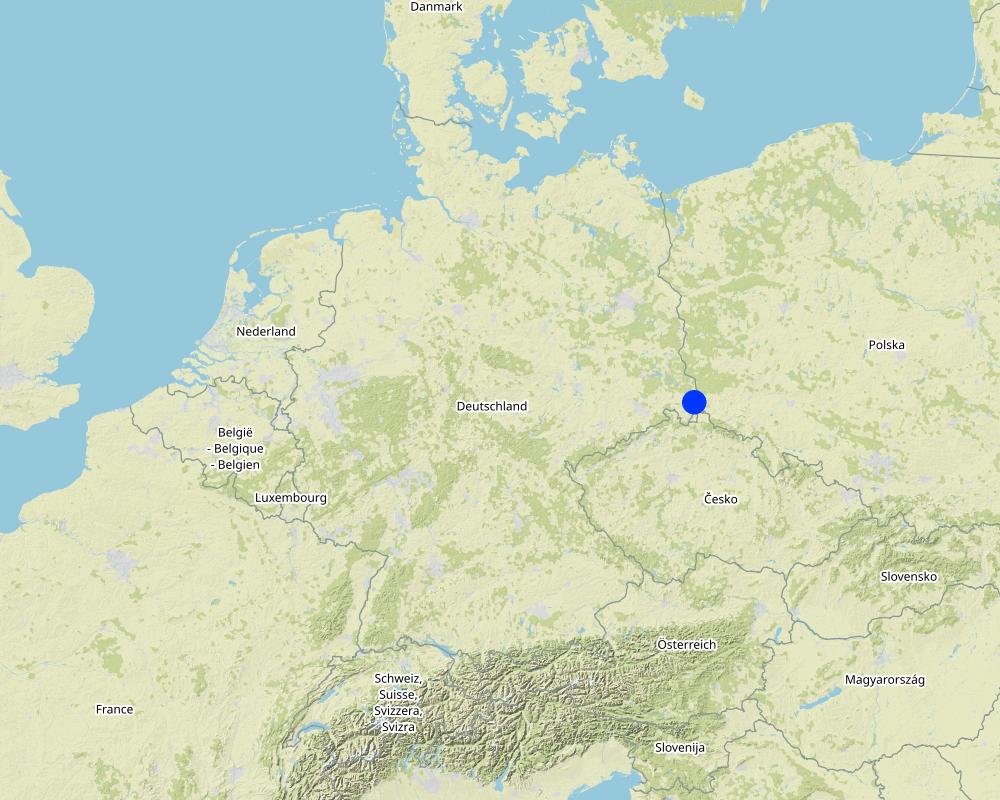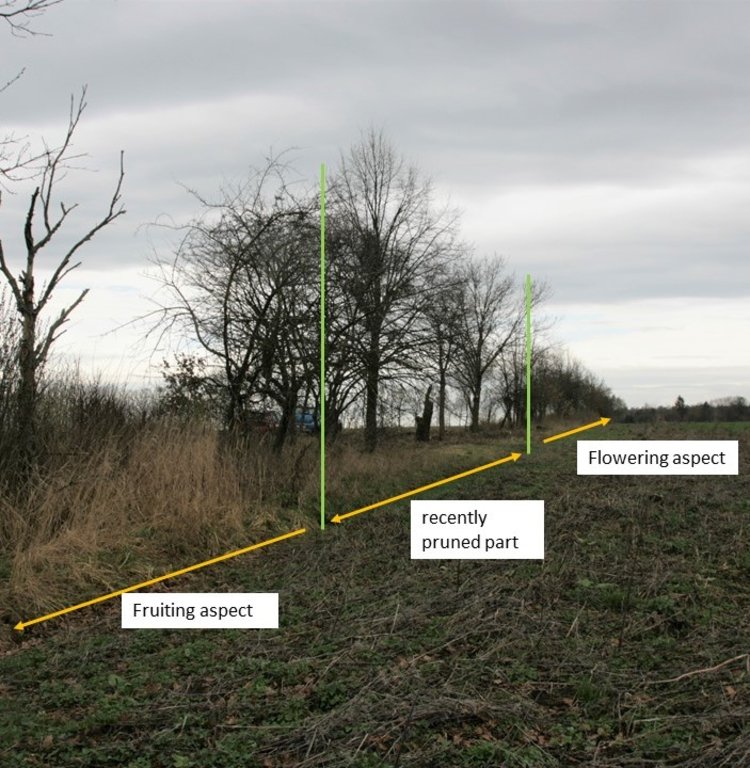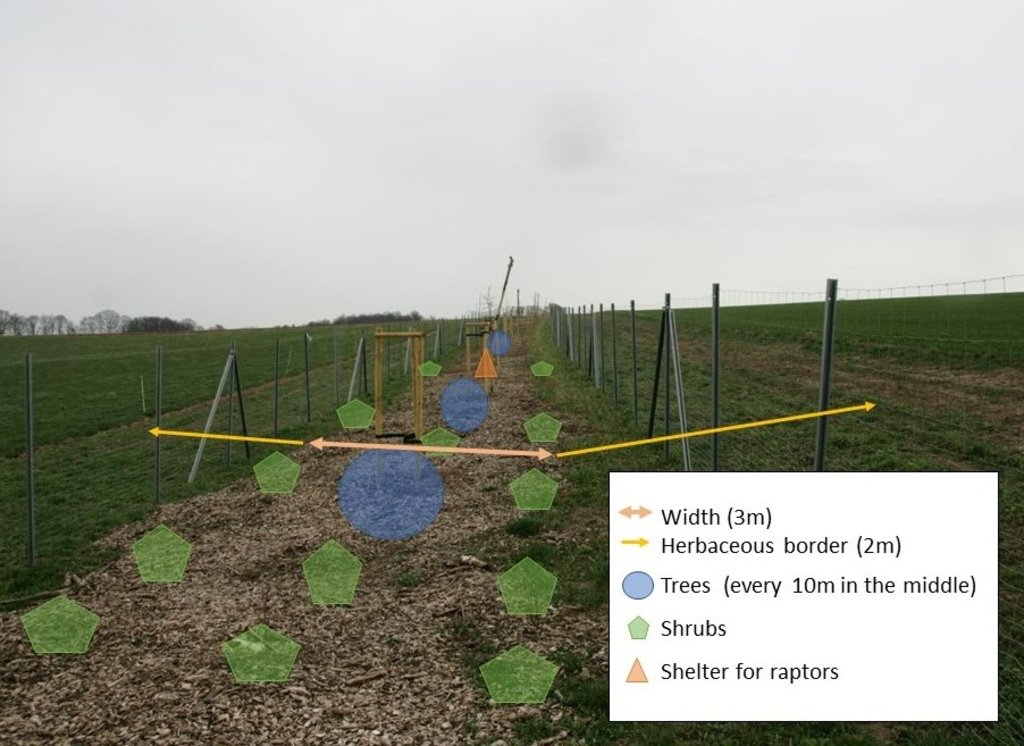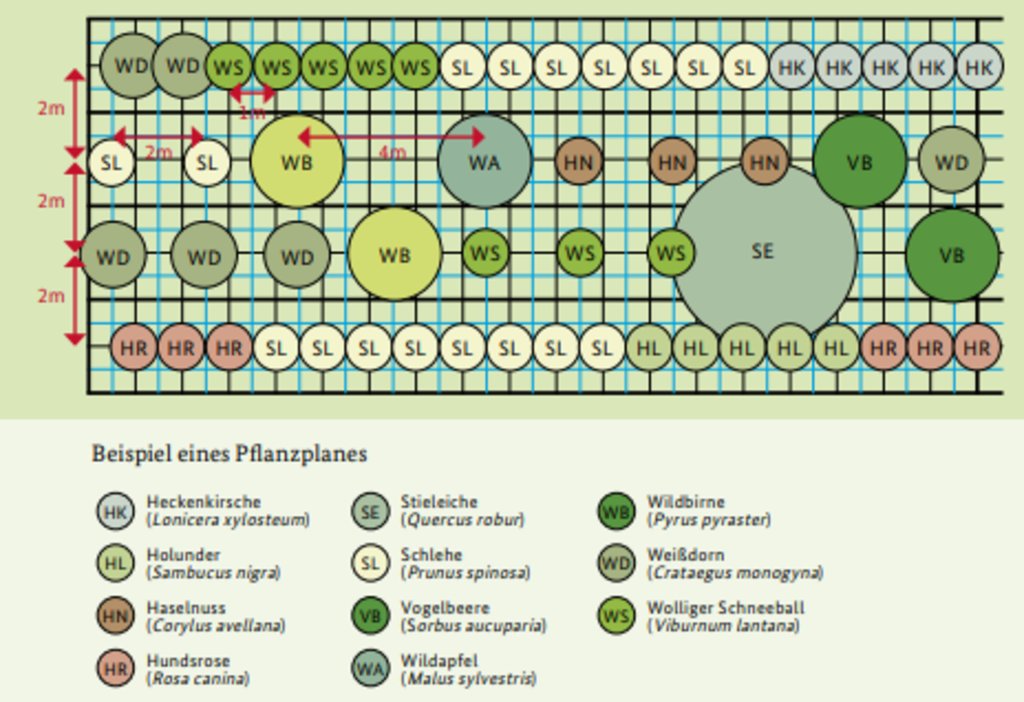Hedges to subdivide fields and provide environmental benefits [เยอรมนี]
- ผู้สร้างสรรค์:
- การอัพเดท:
- ผู้รวบรวม: Felix Witing
- ผู้เรียบเรียง: Michael Strauch, Mona Pauer
- ผู้ตรวจสอบ: William Critchley, Rima Mekdaschi Studer
Hecken und Baumreihen zur Unterteilung von Feldern
technologies_6266 - เยอรมนี
ดูส่วนย่อย
ขยายทั้งหมด ย่อทั้งหมด1. ข้อมูลทั่วไป
1.2 รายละเอียดที่ติดต่อได้ของผู้รวบรวมและองค์กรที่เกี่ยวข้องในการประเมินและการจัดเตรียมทำเอกสารของเทคโนโลยี
ผู้เชี่ยวชาญ SLM:
ผู้เชี่ยวชาญ SLM:
ชื่อของโครงการซึ่งอำนวยความสะดวกในการทำเอกสารหรือการประเมินเทคโนโลยี (ถ้าเกี่ยวข้อง)
OPtimal strategies to retAIN and re-use water and nutrients in small agricultural catchments across different soil-climatic regions in Europe (OPTAIN)ชื่อขององค์กรซึ่งอำนวยความสะดวกในการทำเอกสารหรือการประเมินเทคโนโลยี (ถ้าเกี่ยวข้อง)
Helmholtz Centre for Environmental Research (UFZ) - เยอรมนี1.3 เงื่อนไขการใช้ข้อมูลที่ได้บันทึกผ่านทาง WOCAT
ผู้รวบรวมและวิทยากรหลักยอมรับเงื่อนไขเกี่ยวกับการใช้ข้อมูลที่ถูกบันทึกผ่านทาง WOCAT:
ใช่
1.4 การเปิดเผยเรื่องความยั่งยืนของเทคโนโลยีที่ได้อธิบายไว้
เทคโนโลยีที่ได้อธิบายไว้นี้เป็นปัญหาของความเสื่อมโทรมโทรมของที่ดินหรือไม่ จึงไม่ได้รับการยอมรับว่าเป็นเทคโนโลยีเพื่อการจัดการที่ดินอย่างยั่งยืน:
ไม่ใช่
2. การอธิบายลักษณะของเทคโนโลยี SLM
2.1 การอธิบายแบบสั้น ๆ ของเทคโนโลยี
คำจำกัดความของเทคโนโลยี:
Hedges are structured shrub communities that subdivide fields, reduce soil erosion, and provide valuable semi-natural habitats.
2.2 การอธิบายแบบละเอียดของเทคโนโลยี
คำอธิบาย:
Hedges subdivide large fields and provide multiple other benefits. Improved soil structure, and deep and dense root systems in the hedgerow area result in slowing runoff from adjacent land, increasing infiltration rates and capturing sediment. These factors reduce water erosion and nutrient leaching. On steep slopes or embankments, deep roots can prevent wet soils from slipping. Additionally, hedges can acts as windbreaks and thus reduce wind erosion of light soils: simultaneously soil particles in the air are filtered out by hedges. Hedgerows provide a habitat for various wild animals for their food, reproduction, shelter and retreat. The hedge can act as a measure for natural pest control: for example as a habitat for raptors that control voles. A well-placed hedge may improve the microclimate of a field by reducing wind speed and increasing soil moisture in the wind-protected area.
An effective hedge must be strategically sited and carefully established. The optimal hedge is a multi-row hedgerow (at least three rows) with a herbaceous border on both sides. The width of the hedge should be, ideally, 5-6 m (LfULG, 2014). Hedges are best planted parallel to the contour line, along the direction of cultivation, not on the headland, and should be sited a minimum of 20 m from the nearest road. Preparing a planting plan is very important for the establishment of a hedge. It should be based on native species (Kühne et al., 2018). Planting is usually done from October to November. Since a newly planted hedge requires regular costly watering (100 litres for trees, 20 litres for shrubs) spring planting is not advisable.
Maintenance pruning can be divided into hard pruning (every 10-15 years) and pruning for shape and maintenance (every year). Hedges that are not maintained will lack fruit, develop deadwood, or simply die back. Maintenance pruning should be done in February or March when there is no frost and before the plants sprout. A clean, smooth cut is important to prevent fungi or diseases from entering the plants. Hard pruning of hedges means cutting shrubs to a height of a few centimetres. As a general rule, a hedge should be divided into at least three sections, which should be hard pruned in succession. In this way, the hedge always retains a flowering and a fruiting element. Individual trees should be left as shelter/seed trees. The annual maintenance cuts should be used to shape the hedge, but also to remove broken or diseased branches (NABU Niedersachsen).
Hedgerows also have drawbacks for farmers and landowners. They take up cropland, which initially reduces yields. Once established, they cannot be easily removed, limiting management flexibility. It is uncertain whether hedges will be eligible for financial support or whether they will remain eligible after several years. For example, a hedge in Germany that is initially eligible for financial support must prove, after 10 years, that all the required species are still part of the hedge. If not, the money received from the subsidy must be repaid. Moreover, maintenance requires a lot of work, which needs to be compensated by subsidies (Thünen, 2021).
2.3 รูปภาพของเทคโนโลยี
2.5 ประเทศภูมิภาค หรือสถานที่ตั้งที่เทคโนโลยีได้นำไปใช้และได้รับการครอบคลุมโดยการประเมินนี้
ประเทศ:
เยอรมนี
ภูมิภาค/รัฐ/จังหวัด:
Saxony
ข้อมูลจำเพาะเพิ่มเติมของสถานที่ตั้ง :
Pfaffendorf
ระบุการกระจายตัวของเทคโนโลยี:
- ใช้ ณ จุดที่เฉพาะเจาะจงหรือเน้นไปยังบริเวณพื้นที่ขนาดเล็ก
Is/are the technology site(s) located in a permanently protected area?
ไม่ใช่
Map
×2.6 วันที่การดำเนินการ
ระบุปีที่ใช้:
2003
2.7 คำแนะนำของเทคโนโลยี
ให้ระบุว่าเทคโนโลยีถูกแนะนำเข้ามาอย่างไร:
- ด้วยการริเริ่มของผู้ใช้ที่ดินเอง
ความคิดเห็น (ประเภทของโครงการ เป็นต้น) :
It was the land users’ own decision to implement that hedge. They are doing organic farming and wanted some natural shelter against the pesticide drift from the neighbouring – conventionally managed - fields (this was the main reason, beside other environmental benefits of hedges the land users were aware of).
3. การจัดประเภทของเทคโนโลยี SLM
3.1 วัตถุประสงค์หลักของเทคโนโลยี
- ปรับปรุงการผลิตให้ดีขึ้น
- ลด ป้องกัน ฟื้นฟู การเสื่อมโทรมของที่ดิน
- อนุรักษ์ระบบนิเวศน์
- รักษาสภาพหรือปรับปรุงความหลากหลายทางชีวภาพ
- ปรับตัวเข้ากับการเปลี่ยนแปลงภูมิอากาศของโลก สภาพภูมิอากาศที่รุนแรงและผลกระทบ
3.2 ประเภทของการใช้ที่ดินในปัจจุบันที่ได้นำเทคโนโลยีไปใช้
Land use mixed within the same land unit:
ใช่
Specify mixed land use (crops/ grazing/ trees):
- วนเกษตร (Agroforestry)

พื้นที่ปลูกพืช
- การปลูกพืชล้มลุกอายุปีเดียว
Annual cropping - Specify crops:
- vegetables - root vegetables (carrots, onions, beet, other)
จำนวนของฤดูเพาะปลูกต่อปี:
- 1
Is intercropping practiced?
ไม่ใช่
Is crop rotation practiced?
ใช่
ถ้าใช่ ระบุ:
we have no information about this

ป่า/พื้นที่ทำไม้
- Hedge/ tree row on the field
- rosa villosa (Apfelrose), salix caprea (Salweide)
Are the trees specified above deciduous or evergreen?
- deciduous
ผลิตภัณฑ์และบริการ:
- ผลไม้และถั่ว
- การอนุรักษ์ / ป้องกันธรรมชาติ
3.3 Has land use changed due to the implementation of the Technology?
Has land use changed due to the implementation of the Technology?
- No (Continue with question 3.4)
3.4 การใช้น้ำ
การใช้น้ำของที่ดินที่มีการใช้เทคโนโลยีอยู่:
- จากน้ำฝน
แสดงความคิดเห็น:
Newly planted hedges require regular watering (100 litres for trees, 20 litres for shrubs).
3.5 กลุ่ม SLM ที่ตรงกับเทคโนโลยีนี้
- แนวกันลมหรือแนวต้านลม
- มาตรการปลูกพืชขวางความลาดชัน (cross-slope measure)
- การจัดการศัตรูพืชและโรคพืชแบบผสมผสาน (รวมถึงเกษตรอินทรีย์ด้วย)
3.6 มาตรการ SLM ที่ประกอบกันเป็นเทคโนโลยี

มาตรการอนุรักษ์ด้วยวิธีพืช
- V1: ต้นไม้และพุ่มไม้คลุมดิน
3.7 รูปแบบหลักของการเสื่อมโทรมของที่ดินที่ได้รับการแก้ไขโดยเทคโนโลยี

การกัดกร่อนของดินโดยน้ำ
- Wt (Loss of topsoil): การสูญเสียดินชั้นบนหรือการกัดกร่อนที่ผิวดิน
- Wo (Offsite degradation): ผลกระทบนอกพื้นที่

การกัดกร่อนของดินโดยลม
- Et (Loss of topsoil): การสูญเสียดินชั้นบน
- Ed (Deflation and deposition): การกัดกร่อนโดยลมและการทับถม

การเสื่อมโทรมของดินทางด้านเคมี
- Cp (Soil pollution): มลพิษในดิน

การเสื่อมโทรมของดินทางด้านกายภาพ
- Pc (Compaction): การอัดแน่น
- Pk (Slaking and crusting): การอุดตันของช่องว่างในดินหรือรูพรุน
- Pi (Soil sealing)

การเสื่อมโทรมของดินทางด้านชีวภาพ
- Bc (Reduction of vegetation cover): การลดลงของจำนวนพืชที่ปกคลุมดิน
- Bh (Loss of habitat): การสูญเสียแหล่งที่อยู่
- Bq (Quantity/biomass decline): การลดลงของปริมาณหรือมวลชีวภาพ
- Bs (Quality and species composition): องค์ประกอบหรือความหลากหลายทางคุณภาพและชนิดพันธุ์ลดลง
- Bl (Loss of soil life): การสูญเสียสิ่งมีชีวิตในดิน
- Bp (Increase of pests/diseases): การเพิ่มขึ้นของศัตรูพืชและโรคพืช

การเสื่อมโทรมของน้ำ
- Hs (Change in quantity of surface water): การเปลี่ยนแปลงปริมาณของน้ำที่ผิวดิน
- Hp (Decline of surface water quality): การลดลงของคุณภาพน้ำที่ผิวดิน
แสดงความคิดเห็น:
Physical soil degradation refers to the area below the hedge and next to the hedge (3-4 m), but not around it, e.g. in the field. Other types of degradation do refer to the area around the hedge.
3.8 การป้องกัน การลดลง หรือการฟื้นฟูความเสื่อมโทรมของที่ดิน
ระบุเป้าหมายของเทคโนโลยีกับความเสื่อมโทรมของที่ดิน:
- ป้องกันความเสื่อมโทรมของที่ดิน
- ลดความเสื่อมโทรมของดิน
4. ข้อมูลจำเพาะด้านเทคนิค กิจกรรมการนำไปปฏิบัติใช้ ปัจจัยนำเข้า และค่าใช้จ่าย
4.1 แบบแปลนทางเทคนิคของเทคโนโลยี
ข้อมูลจำเพาะด้านเทคนิค (แบบแปลนทางเทคนิคของเทคโนโลยี):
From a conservation point of view, a well-maintained hedge should always have a flowering aspect (the right part of the hedge in the picture) and a fruiting aspect (the left part of the hedge). After pruning, there is neither a flowering aspect nor a fruiting aspect, so the hedge is divided into at least three maintenance sections with different times for pruning.
ผู้เขียน:
Mona Pauer
วันที่:
23/03/2023
ข้อมูลจำเพาะด้านเทคนิค (แบบแปลนทางเทคนิคของเทคโนโลยี):
A hedge should have at least three rows of taller woody plants (trees) every 10 m in the center to low woody plants (shrubs) at the edges. A herbaceous border on both sides is ideal. The width of the strip should be between 5 and 9 meters. An important guide before planting is a planting plan (an example is given in the online version of this documentation).
ผู้เขียน:
Mona Pauer (based on a example of a planting plan in Kühne et al. 2018, p.73)
วันที่:
23/03/2023
ข้อมูลจำเพาะด้านเทคนิค (แบบแปลนทางเทคนิคของเทคโนโลยี):
Example of a planting plan for a three-row-hedge
ผู้เขียน:
Kühne et al. 2018, p. 73
4.2 ข้อมูลทั่วไปเกี่ยวกับการคำนวณปัจจัยนำเข้าและค่าใช้จ่าย
ให้ระบุว่าค่าใช้จ่ายและปัจจัยนำเข้าได้รับการคำนวณอย่างไร:
- ต่อพื้นที่ที่ใช้เทคโนโลยี
ระบุขนาดและหน่วยพื้นที่:
1 m²
อื่นๆ หรือสกุลเงินประจำชาติ (ระบุ):
€
If relevant, indicate exchange rate from USD to local currency (e.g. 1 USD = 79.9 Brazilian Real): 1 USD =:
0.91
ระบุค่าเฉลี่ยของค่าจ้างในการจ้างแรงงานต่อวัน:
18.70€ per hour
4.3 กิจกรรมเพื่อการจัดตั้ง
| กิจกรรม | Timing (season) | |
|---|---|---|
| 1. | Planning / preparing a planting plan | anytime but before planting |
| 2. | Preparing area (preparation of the soil, e.g. ploughing) | late summer- atumn |
| 3. | Planting | late summer- autumn |
| 4. | Protection measures for newly planted hedge (application of a protective coating, construction of protective fence) | after planting |
| 5. | Maintenance measures for newly planted hedge | especially the first year after planting |
| 6. | Optional: preparing area of herbarcious border (preparation of soil) | late summer- atumn |
| 7. | Optional: sawing of herbacious border | late summer- atumn |
| 8. | Optional: rolling of herbacious border | late summer- atumn |
4.4 ค่าใช้จ่ายของปัจจัยนำเข้าที่จำเป็นสำหรับการจัดตั้ง
If you are unable to break down the costs in the table above, give an estimation of the total costs of establishing the Technology:
25.0
ถ้าผู้ใช้ที่ดินรับภาระน้อยกว่า 100% ของค่าใช้จ่าย ให้ระบุว่าใครเป็นผู้รับผิดชอบส่วนที่เหลือ:
7.54 €/m² are covered by the state of Saxony, RL Ne/ 2014- Planting hedges, copses and riparian woods (SMUL Sachsen a)
แสดงความคิดเห็น:
The implementation costs of a hedge include the plants (trees, shrubs, grass seed) and required materials (e.g. fencing, perches for birds of prey, anti-mole mesh, trunk protection, bark mulch) and the rental of required machinery.
4.5 การบำรุงรักษาสภาพหรือกิจกรรมที่เกิดขึ้นเป็นประจำ
| กิจกรรม | ช่วงระยะเวลา/ความถี่ | |
|---|---|---|
| 1. | Cuts to put hedges on stock | every 5-10 years |
| 2. | Shape and maintenance cuts | every year |
แสดงความคิดเห็น:
In our documentation, the landscape maintenance association will check the hedge every five years to see how much it has grown back and whether or not it can be put back on the stock.
4.6 ค่าใช้จ่ายของปัจจัยนำเข้าและกิจกรรมที่เกิดขึ้นเป็นประจำที่ต้องการการบำรุงรักษา (ต่อปี)
If you are unable to break down the costs in the table above, give an estimation of the total costs of maintaining the Technology:
11.73
ถ้าผู้ใช้ที่ดินรับภาระน้อยกว่า 100% ของค่าใช้จ่าย ให้ระบุว่าใครเป็นผู้รับผิดชอบส่วนที่เหลือ:
3.91 €/m² are covered by the state of Saxony, RL Ne/ 2014- Woody plant rehabilitation - Hard pruning (SMUL Sachsen b)
แสดงความคิดเห็น:
Costs only include maintenance activity 'hard pruning' over a five year period.
4.7 ปัจจัยสำคัญที่สุดที่มีผลกระทบต่อค่าใช้จ่าย
ปัจจัยสำคัญที่สุดที่มีผลกระทบต่อค่าใช้จ่ายต่างๆ:
The implementation costs of a hedge are rather high and include the plants (trees, shrubs, grass seed), required materials (e.g. fencing, perches for birds of prey, anti-mole mesh, trunk protection, bark mulch), the rental of required machinery and irrigation.
5. สิ่งแวดล้อมทางธรรมชาติและของมนุษย์
5.1 ภูมิอากาศ
ฝนประจำปี
- < 250 ม.ม.
- 251-500 ม.ม.
- 501-750 ม.ม.
- 751-1,000 ม.ม.
- 1,001-1,500 ม.ม.
- 1,501-2,000 ม.ม.
- 2,001-3,000 ม.ม.
- 3,001-4,000 ม.ม.
- > 4,000 ม.ม.
ระบุปริมาณน้ำฝนเฉลี่ยรายปี (ถ้ารู้) :หน่วย ม.ม.
745.00
ระบุชื่อของสถานีตรวดวัดอากาศที่ใช้อ้างอิงคือ:
https://whh-kliwes.de/mapview
เขตภูมิอากาศเกษตร
- กึ่งชุ่มชื้น
Length of growing period (LGP): 209 days (https://www.umwelt.sachsen.de/dauer-der-vegetationsperiode-30631.html)
5.2 สภาพภูมิประเทศ
ค่าเฉลี่ยความลาดชัน:
- ราบเรียบ (0-2%)
- ลาดที่ไม่ชัน (3-5%)
- ปานกลาง (6-10%)
- เป็นลูกคลื่น (11-15%)
- เป็นเนิน (16-30%)
- ชัน (31-60%)
- ชันมาก (>60%)
ธรณีสัณฐาน:
- ที่ราบสูง/ที่ราบ
- สันเขา
- ไหล่เขา
- ไหล่เนินเขา
- ตีนเนิน
- หุบเขา
ระดับความสูง:
- 0-100 เมตร
- 101-500 เมตร
- 501-1,000 เมตร
- 1,001-1,500 เมตร
- 1,501-2,000 เมตร
- 2,001-2,500 เมตร
- 2,501-3,000 เมตร
- 3,001-4,000 เมตร
- > 4,000 เมตร
ให้ระบุถ้าเทคโนโลยีได้ถูกนำไปใช้:
- ไม่เกี่ยวข้อง
5.3 ดิน
ค่าเฉลี่ยความลึกของดิน:
- ตื้นมาก (0-20 ซ.ม.)
- ตื้น (21-50 ซ.ม.)
- ลึกปานกลาง (51-80 ซ.ม.)
- ลึก (81-120 ซ.ม.)
- ลึกมาก (>120 ซ.ม.)
เนื้อดิน (ดินชั้นบน):
- ปานกลาง (ดินร่วน ทรายแป้ง)
เนื้อดินล่าง (> 20 ซ.ม.ต่ำจากผิวดิน):
- ปานกลาง (ดินร่วน ทรายแป้ง)
อินทรียวัตถุในดิน:
- ปานกลาง (1-3%)
(ถ้ามี) ให้แนบคำอธิบายเรื่องดินแบบเต็มหรือระบุข้อมูลที่มีอยู่ เช่น ชนิดของดิน ค่า pH ของดินหรือความเป็นกรดของดิน ความสามารถในการแลกเปลี่ยนประจุบวก ไนโตรเจน ความเค็ม เป็นต้น:
Luvisol (Pseudogley Parabraunerde)
5.4 ความเป็นประโยชน์และคุณภาพของน้ำ
ระดับน้ำใต้ดิน:
<5 เมตร
น้ำไหลบ่าที่ผิวดิน:
ปานกลาง
คุณภาพน้ำ (ที่ยังไม่ได้บำบัด):
เป็นน้ำเพื่อการดื่มที่ไม่ดี (จำเป็นต้องได้รับการบำบัด)
Water quality refers to:
surface water
ความเค็มของน้ำเป็นปัญหาหรือไม่:
ไม่ใช่
กำลังเกิดน้ำท่วมในพื้นที่หรือไม่:
ไม่ใช่
5.5 ความหลากหลายทางชีวภาพ
ความหลากหลายทางชนิดพันธุ์:
- สูง
ความหลากหลายของแหล่งที่อยู่:
- สูง
ความคิดเห็นและข้อมูลจำเพาะเพิ่มเติมของความหลากหลายทางชีวภาพ:
High diversity only because of the hedgerow. Without, it would be low to medium.
5.6 ลักษณะของผู้ใช้ที่ดินที่นำเทคโนโลยีไปปฏิบัติใช้
อยู่กับที่หรือเร่ร่อน:
- อยู่กับที่
แนวทางการตลาดของระบบการผลิต:
- ทำการค้า/การตลาด
รายได้ที่มาจากนอกฟาร์ม:
- < 10% ของรายได้ทั้งหมด
ระดับของความมั่งคั่งโดยเปรียบเทียบ:
- จน
- พอมีพอกิน
เป็นรายบุคคล/ครัวเรือน:
- กลุ่ม/ชุมชน
ระดับของการใช้เครื่องจักรกล:
- การใช้เครื่องจักรหรือเครื่องยนต์
เพศ:
- หญิง
- ชาย
อายุของผู้ใช้ที่ดิน:
- วัยกลางคน
ระบุลักษณะอื่นๆที่เกี่ยวข้องของผู้ใช้ที่ดิน:
Organic farm community (demeter quality)
5.7 Average area of land used by land users applying the Technology
- < 0.5 เฮกตาร์
- 0.5-1 เฮกตาร์
- 1-2 เฮกตาร์
- 2-5 เฮกตาร์
- 5-15 เฮกตาร์
- 15-50 เฮกตาร์
- 50-100 เฮกตาร์
- 100-500 เฮกตาร์
- 500-1,000 เฮกตาร์
- 1,000-10,000 เฮกตาร์
- >10,000 เฮกตาร์
แสดงความคิดเห็น:
not known
5.8 กรรมสิทธิ์ในที่ดิน สิทธิในการใช้ที่ดินและสิทธิในการใช้น้ำ
กรรมสิทธิ์ในที่ดิน:
- รายบุคคล ไม่ได้รับสิทธิครอบครอง
สิทธิในการใช้ที่ดิน:
- เช่า
- รายบุคคล
สิทธิในการใช้น้ำ:
- เกี่ยวกับชุมชน (ถูกจัดระเบียบ)
Are land use rights based on a traditional legal system?
ไม่ใช่
5.9 การเข้าถึงบริการและโครงสร้างพื้นฐาน
สุขภาพ:
- จน
- ปานกลาง
- ดี
การศึกษา:
- จน
- ปานกลาง
- ดี
ความช่วยเหลือทางด้านเทคนิค:
- จน
- ปานกลาง
- ดี
การจ้างงาน (เช่น ภายนอกฟาร์ม):
- จน
- ปานกลาง
- ดี
ตลาด:
- จน
- ปานกลาง
- ดี
พลังงาน:
- จน
- ปานกลาง
- ดี
ถนนและการขนส่ง:
- จน
- ปานกลาง
- ดี
น้ำดื่มและการสุขาภิบาล:
- จน
- ปานกลาง
- ดี
บริการด้านการเงิน:
- จน
- ปานกลาง
- ดี
6. ผลกระทบและสรุปคำบอกกล่าว
6.1 ผลกระทบในพื้นที่ดำเนินการ (On-site) จากการใช้เทคโนโลยี
ผลกระทบทางด้านเศรษฐกิจและสังคม
การผลิต
การผลิตพืชผล
คุณภาพพืชผล
แสดงความคิดเห็น/ระบุ:
Less input of pesticides from conventional agriculture.
การเสี่ยงต่อความล้มเหลวในการผลิต
แสดงความคิดเห็น/ระบุ:
In direct surrounding of the hedge.
พื้นที่สำหรับการผลิต
รายได้และค่าใช้จ่าย
ค่าใช่จ่ายของปัจจัยการผลิตทางการเกษตร
รายได้จากฟาร์ม
ความหลากหลายของแหล่งผลิตรายได้
แสดงความคิดเห็น/ระบุ:
Possible to sell berries and fruits from the hedge.
ภาระงาน
ผลกระทบด้านนิเวศวิทยา
วัฐจักรน้ำหรือน้ำบ่า
น้ำไหลบ่าที่ผิวดิน
ดิน
ความชื้นในดิน
แสดงความคิดเห็น/ระบุ:
In direct surrounding of the hedge.
สิ่งปกคลุมดิน
แสดงความคิดเห็น/ระบุ:
Considering the area of hedge.
การสูญเสียดิน
การสะสมของดิน
การอัดแน่นของดิน
แสดงความคิดเห็น/ระบุ:
In direct surrounding of the hedge.
อินทรียวัตถุในดิน/ต่ำกว่าดินชั้น C
แสดงความคิดเห็น/ระบุ:
In direct surrounding of the hedge.
ความหลากหลายทางชีวภาพของพืชและสัตว์
การปกคลุมด้วยพืช
ความหลากหลายทางชีวภาพของพืช
พืชพันธุ์ต่างถิ่นที่รุกล้ำเข้ามา
แสดงความคิดเห็น/ระบุ:
It is important to use local planting/maintenance materials, e.g. regarding wood chips.
ความหลากหลายทางชีวภาพของสัตว์
ชนิดพันธุ์ที่ให้ประโยชน์
ความหลากหลายของสัตว์
การจัดการศัตรูพืชและโรคพืช
ลดความเสี่ยงของภัยพิบัติ
ผลกระทบจากภัยแล้ง
แสดงความคิดเห็น/ระบุ:
In direct surrounding of the hedge.
ความเร็วของลม
ภูมิอากาศจุลภาค
Specify assessment of on-site impacts (measurements):
Estimates based on land users' perception (not based on measurements).
6.2 ผลกระทบนอกพื้นที่ดำเนินการ (Off-site) จากการใช้เทคโนโลยี
น้ำที่ใช้ประโยชน์ได้
แสดงความคิดเห็น/ระบุ:
Impact decreases with distance from the hedge.
การเกิดมลพิษในน้ำบาดาลหรือแม่น้ำ
ความสามารถต้านทานการเปลี่ยนแปลง / ความสามารถในการคัดกรอง
แสดงความคิดเห็น/ระบุ:
Impact decreases with distance from the hedge.
ตะกอนที่ถูกพัดพามาโดยลม
ความเสียหายต่อพื้นที่เพาะปลูกของเพื่อนบ้าน
ผลกระทบของก๊าซเรือนกระจก
แสดงความคิดเห็น/ระบุ:
Impact decreases with distance from the hedge.
Specify assessment of off-site impacts (measurements):
Estimates based on land users' perception (not based on measurements).
6.3 การเผชิญและความตอบสนองของเทคโนโลยีต่อการเปลี่ยนแปลงสภาพภูมิอากาศที่ค่อยเป็นค่อยไป และสภาพรุนแรงของภูมิอากาศ / ภัยพิบัติ (ที่รับรู้ได้โดยผู้ใช้ที่ดิน)
การเปลี่ยนแปลงสภาพภูมิอากาศที่ค่อยเป็นค่อยไป
การเปลี่ยนแปลงสภาพภูมิอากาศที่ค่อยเป็นค่อยไป
| ฤดู | increase or decrease | เทคโนโลยีมีวิธีการรับมืออย่างไร | |
|---|---|---|---|
| อุณหภูมิตามฤดูกาล | ฤดูใบไม้ผลิ | เพิ่มขึ้น | ไม่ค่อยดี |
| การเปลี่ยนแปลงสภาพภูมิอากาศที่ค่อยเป็นค่อยไปอื่น ๆ | heavy rain events | เพิ่มขึ้น | ดี |
6.4 การวิเคราะห์ค่าใช้จ่ายและผลประโยชน์ที่ได้รับ
ผลประโยชน์ที่ได้รับเปรียบเทียบกับค่าใช้จ่ายในการจัดตั้งเป็นอย่างไร (จากมุมมองของผู้ใช้ที่ดิน)
ผลตอบแทนระยะสั้น:
ด้านลบ
ผลตอบแทนระยะยาว:
ด้านบวกเล็กน้อย
ผลประโยชน์ที่ได้รับเปรียบเทียบกับค่าใช้จ่ายในการบำรุงรักษาหรือต้นทุนที่เกิดขึ้นซ้ำอีก เป็นอย่างไร (จากมุมมองของผู้ใช้ที่ดิน)
ผลตอบแทนระยะสั้น:
ด้านลบเล็กน้อย
ผลตอบแทนระยะยาว:
ด้านบวก
แสดงความคิดเห็น:
This is a reasonable estimate from the SLM specialist's perspective, but not from the land user's perspective.
6.5 การปรับตัวของเทคโนโลยี
- ครั้งเดียวหรือเป็นการทดลอง
6.6 การปรับตัว
เทคโนโลยีได้รับการปรับเปลี่ยนเมื่อเร็วๆนี้ เพื่อให้ปรับตัวเข้ากับสภาพที่กำลังเปลี่ยนแปลงหรือไม่:
ใช่
ถ้าตอบว่าใช่ ให้ระบุว่าเงื่อนไขการเปลี่ยนแปลงใดที่ถูกปรับตัว:
- การเปลี่ยนแปลงแบบค่อยเป็นค่อยไปและสภาพรุนแรงของภูมิอากาศ
ให้ระบุการปรับตัวของเทคโนโลยี (การออกแบบ วัสดุหรือชนิดพันธุ์ เป็นต้น):
no planting in spring
6.7 จุดแข็ง / ข้อได้เปรียบ / โอกาสของเทคโนโลยี
| จุดแข็ง / ข้อได้เปรียบ / โอกาสในทัศนคติของผู้ใช้ที่ดิน |
|---|
| The hedge as a habitat acts as a natural plant protection measure, e.g. the hedge as a habitat for raptors can be a pest control measure against voles. |
| Protection against drift from conventional crop protection products. |
| จุดแข็ง / ข้อได้เปรียบ / โอกาสในทัศนคติของผู้รวบรวมหรือวิทยากรหลัก |
|---|
| Promoting biodiversity (habitats for bees, birds and amphibians) |
| Reducing soil erosion (wind and water) |
| Improve micro-climate (may increase yield) |
| On steep slopes or embankments, deep roots prevent wet soils from slipping. |
6.8 จุดอ่อน / ข้อเสียเปรียบ / ความเสี่ยงของเทคโนโลยีและวิธีการแก้ไข
| จุดอ่อน / ข้อเสียเปรียบ / ความเสี่ยงในทัศนคติของผู้ใช้ที่ดิน | มีวิธีการแก้ไขได้อย่างไร |
|---|---|
| Consume cropland, which initially leads to a reduces yields. | A better compensation by subsidies is required. |
| จุดอ่อน / ข้อเสียเปรียบ / ความเสี่ยงในทัศนคติของผู้รวบรวมหรือวิทยากรหลัก | มีวิธีการแก้ไขได้อย่างไร |
|---|---|
| Once established, hedgerows cannot be easily removed, which limits management flexibility. | Farmers should consider management and practicality when planning the hedge. |
| Insufficient market opportunities for shrub cuttings. | Farmers could use shrub cuttings to mulch the hedge or eventually for replanting trees / further hedges. |
| Maintenance includes a lot of labor. | These efforts should therefore be compensated by subsidies. |
| Increased machinery operation costs and fuel use (so greater carbon dioxide emissions) because of more turning and shorter machine runs. | Farmers should consider this when planning the hedge, e.g. fields should not be cut into too small parts which are impractical or too expensive to be managed. |
7. การอ้างอิงและการเชื่อมต่อ
7.1 วิธีการและแหล่งข้อมูล
- ไปเยี่ยมชมภาคสนาม การสำรวจพื้นที่ภาคสนาม
3
- การสัมภาษณ์ผู้เชี่ยวชาญด้าน SLM หรือผู้ชำนาญ
2
- การเก็บรวบรวมมาจากรายงานและเอกสารที่มีอยู่
วันที่เก็บรวบรวมข้อมูล(ภาคสนาม) :
23/03/2023
7.2 การอ้างอิงถึงสิ่งตีพิมพ์
หัวข้อ, ผู้เขียน, ปี, หมายเลข ISBN:
Kühne et al. 2018: Hecken und Raine in der Agrarlandschaft- Bedeutung, Neuanlage, Pflege
ชื่อเรื่อง ผู้เขียน ปี ISBN:
ble-medienservice.de, download: https://www.ble-medienservice.de/1619-1-hecken-und-raine-in-der-agrarlandschaft.html , free
หัวข้อ, ผู้เขียน, ปี, หมายเลข ISBN:
Weber, E. 2003: Gebüsche, Hecken, Krautsäume
ชื่อเรื่อง ผู้เขียน ปี ISBN:
ulmer.de
7.3 Links to relevant online information
ชื่อเรื่องหรือคำอธิบาย:
SMUL Sachsen 2021a: Anlage von Hecken, Feldgehölzen und Ufergehölzen (RL NE/2014)
URL:
https://www.smul.sachsen.de/foerderung/download/MB_Anlage_Hecken_Feld_Ufergehoelze_01.11.2021.pdf
ชื่อเรื่องหรือคำอธิบาย:
NABU Niedersachsen: Hecken pflegen - so geht's
URL:
https://niedersachsen.nabu.de/tiere-und-pflanzen/pflanzen/hecken/04719.html
ชื่อเรื่องหรือคำอธิบาย:
Thünen 2021: Hecken sind Klimaschützer
URL:
https://www.thuenen.de/de/fachinstitute/laendliche-raeume/lebensverhaeltnisse-in-laendlichen-raeumen/aktuelles-und-service/pressemitteilungen/detail-1-5/hecken-sind-klimaschuetzer
ชื่อเรื่องหรือคำอธิบาย:
Wasserhaushaltsportal Sachsen: KLiWES 2.1 IST-Zustand 1988-2015
URL:
https://whh-kliwes.de/mapview
ชื่อเรื่องหรือคำอธิบาย:
SMUL Sachsen 2021b: Gehölzsanierung Hecken, Feld- und Ufergehölze (RL NE/2014)
URL:
https://www.smekul.sachsen.de/foerderung/download/MB_Gehoelzsanierung_Hecken_01052022.pdf
ลิงก์และโมดูล
ขยายทั้งหมด ย่อทั้งหมดลิงก์
ไม่มีลิงก์
โมดูล
ไม่มีโมดูล


